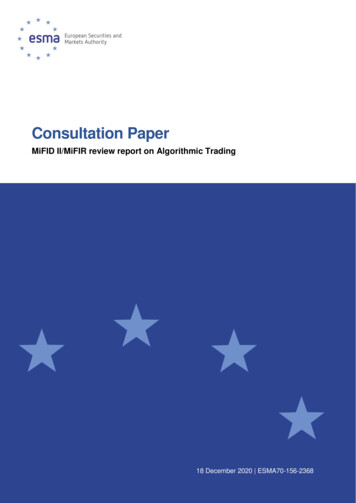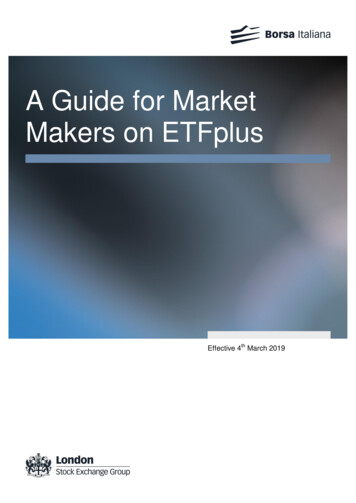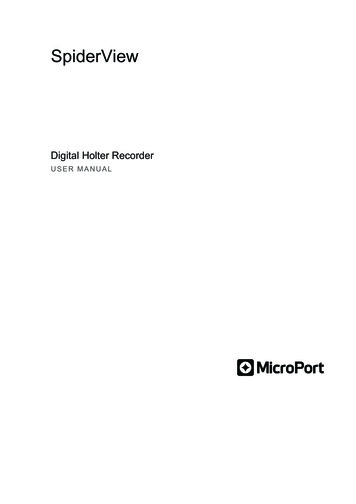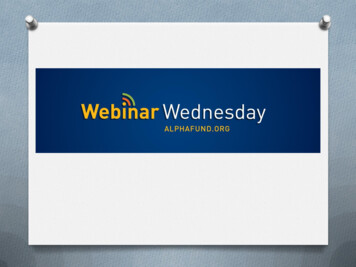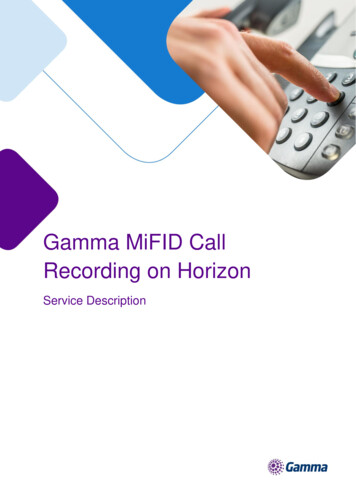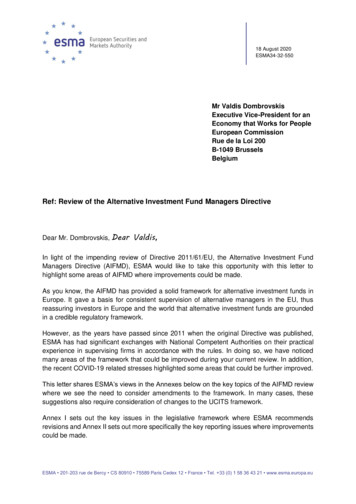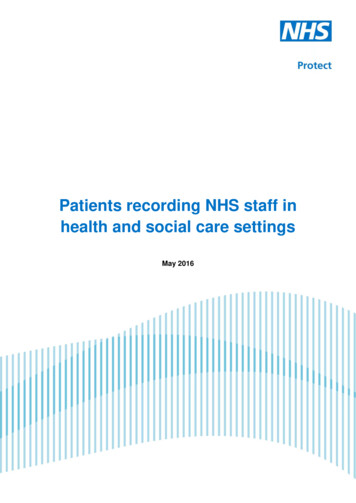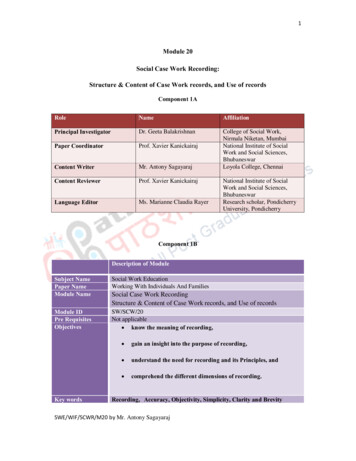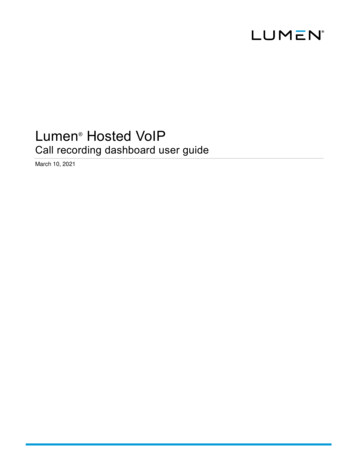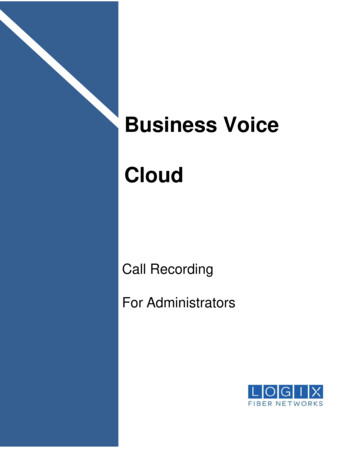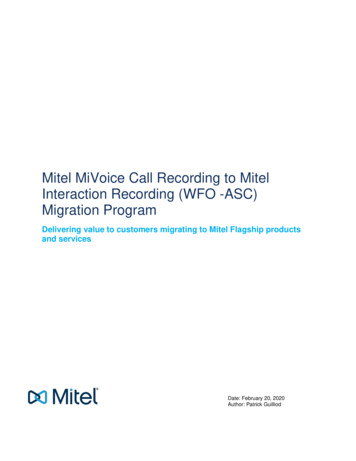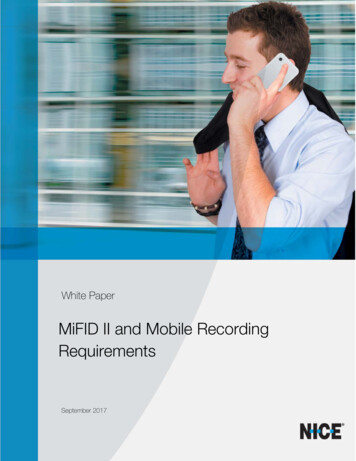
Transcription
White PaperMiFID II and Mobile RecordingRequirementsSeptember 2017
MiFID II and Mobile Recording RequirementsTable of Contents12345What is the MiFID II Directive? . 31.1History . 31.2MiFID . 31.3MiFID II . 3Purpose of a Directive? . 42.1Overview . 42.2Explanation . 42.3Conclusion . 4Why Mobile Phones Must Be Recorded. 53.1Overview . 53.2Limiting Potential for Market Abuse . 53.3Explanation . 63.4How do Firms Protect Themselves? . 63.5Conclusion . 6The Urgency is Clear . 74.1Overview . 74.2Explanation . 74.3Conclusion . 8Mobile Phone Recording Solutions to Ensure Compliance . 95.1The Challenges Associated with Self-Initiated and In-Network Mobile Recording . 95.2Capture All Communications in a Single Platform . 95.3Achieve Complete Compliance Assurance .105.4Conclusion .102
MiFID II and Mobile Recording Requirements1 What is the MiFID II Directive?1.1 HistoryFacilitating economic growth and cooperation among European states has been a prominent goalof the European Union (EU) since it was established. The Investment Services Directive (ISD) wasone of the first major attempts towards harmonizing investor protection and capital movementthroughout the EU. Adopted in 1993, the ISD sought “to improve the competitiveness of EUfinancial markets by creating a single market for investment services and activities.” For 14 years,the ISD facilitated the development of harmonized protection for investors in various financialinstruments, such as shares, bonds, derivatives and a variety of structured products.1.2 MiFIDIn November 2007, the ISD was replaced with the Markets in Financial Instruments Directive, morecommonly known as MiFID. The drafters took substantial steps forward toward a single EU marketby evolving the ISD, which focused on “minimum harmonization,” to MiFID, which focused on “verywide harmonization.” Conceptually, ISD aimed at standardizing the “initial authorization andoperating requirements for investment firms, including conduct of business rules ” and “someconditions governing the operation of regulated markets.” 1 MiFID expanded that focus, aiming toensure “the degree of harmonization needed to offer investors a high level of protection and toallow investment firms to provide services throughout the Community.” 2MiFID has contributed to a more competitive and integrated EU financial market. However, the2008 financial crisis and other market developments demonstrated weaknesses in some of theunderlying principles of MiFID. In order to bolster investor confidence and achieve all of MiFID'soriginal objectives, the European Commission decided to revise the Directive with an emphasis onsafety, soundness and transparency.1.3 MiFID IIEnter the MiFID II Directive. Taking effect on 3 January 2018, MiFID II consists of new rulesregarding trade inducements, research, best execution, market transparency, algorithmic tradingand communication recording. Arguably the most extensive financial regulation imposed on the EUto date, MiFID II aims to create a more responsible financial system for the economy and society asa whole.In a FAQ document that in part explained why MiFID II was necessary, the European Commissionstated: “Ensuring a more robust regulatory framework will also serve to address the more complexmarket reality we are now faced with, a reality which is characterized by increasing diversity infinancial instruments and new methods of /EN/TXT/?uri CELEX%3A32004L0039http://ec.europa.eu/internal ir-6-2-06-final en.pdf3http://europa.eu/rapid/press-release MEMO-14-305 en.htm#footnote-1123
MiFID II and Mobile Recording Requirements2 Purpose of a Directive?2.1 OverviewIn discussions about MiFID II, this question often gets lost or glanced over entirely. However, it isimportant to understand some basic information about how the European Union imposes rulesupon Member States.2.2 ExplanationThe EU has primarily two methods of rulemaking; regulations and directives.Regulations are self-executing, which means they automatically take effect as written in everyMember State. Directives, such as MiFID II, must be adopted by the individual Member Statesbefore they take effect.This allows the EU to create a broad initiative, but grants the individual Member States somediscretion on how to implement it. The distinction is important since many areas of MiFID II indicateactions that should be done, as opposed to those that must be done.2.3 ConclusionBy their very nature, Directives can vary widely depending upon how the Member State chooses toimplement them. Furthermore, transactions that traverse international boundaries may findthemselves subject to adaptation by both countries. This adds additional layers of complexity to analready colossal undertaking.In response to a Directive, any technology solution implemented by global firms must not only berobust enough to satisfy the requirements of the host nation, but also flexible enough to conform toany cross-border nuisances. Traditionally, financial institutions purchase solutions based on theirown regional needs, without any considerations given to boundary crossover. Given the highlikelihood of transnational differences, Banks impacted by MiFID II should ensure that any solutionsthey adopt not only satisfy the requirements of the host country, but also satisfy the requirementsof all other countries in which they do business. This approach will reduce operational challengesto implementation, and increases the probability of multinational compliance.4
MiFID II and Mobile Recording Requirements3 Why Mobile Phones Must Be Recorded3.1 OverviewIn the modern world, customers expect round-the-clock, real-time responsiveness – which requires theuse of a mobile device. Communications around financial transactions are no exception and theinvesting public expects that level of service from their preferred financial institution.MiFID II expands on the current mandate requiring firms to record communications. Therecording requirements will now cover all telephone conversations and electronic communicationsrelating to activities intended to result in the conclusion of a transaction or the provision of clientorder services - even if they in fact do not. In short, MiFID II imposes an obligation to record ALLrelevant telephone conversations and electronic communications – including those which takeplace on mobile phones.In general, there are three main reasons for imposing a recording requirement on communicationsrelated to transactions: To ensure evidence exists to resolve disputes between firms and clients;To assist those empowered to supervise code of conduct adherence within the firm; andTo help deter market abuse, through enhanced detection.When disputes arise between a firm and a client, they can often be resolved in-house withoutfurther escalation. Far more frequently, it is difficult for compliance departments, authorities, orregulators to detect market abuse and prove malicious action. “Evidence collected throughrecording obligations can provide additional material for discovering the facts of a case.” 4Regardless of the outcome, recorded evidence is compelling, and can sometimes even refuteinformation presented through documentation or oral testimony.Recital 144 5 further illustrates the importance placed upon recordings:Existing recordings of telephone conversations and data traffic records frominvestment firms executing and documenting the executions oftransactions constitute crucial, and sometimes the only, evidence to detect andprove the existence of market abuse as well as verify compliance by firms withinvestor protection and other requirements set out in this Directive 3.2 Limiting Potential for Market AbuseAside from evidentiary value, recording can prevent market abuse. Consider for a moment how muchhigher the risk of market abuse would be if your firm only recorded and monitored trading, front-office,and back-office communications, and excluded communications on mobile phones. A few badactors would instantly have a clandestine tool to perform all manner of untraceable fraud. Given theimportance in today society, excluding mobile recording affectively nullifies the directive’s purpose ofincreasing certainty, investor protection, and deterring marking abuse.45CESR/10-859Recital 144, MiFID II5
MiFID II and Mobile Recording Requirements3.3 ExplanationArticle 16(7) states, “an investment firm shall take all reasonable steps to record relevant telephoneconversations and electronic communications, made with, sent from or received by equipmentprovided by the investment firm to an employee or contractor or the use of which by an employeeor contractor has been accepted or permitted by the investment firm.”Although some have questioned what is considered “reasonable” under the Directive, the EC wentfurther requiring that “[a]n investment firm shall take all reasonable steps to prevent an employeeor contractor from making, sending or receiving relevant telephone conversations and electroniccommunication on privately-owned equipment which the investment firm is unable to record orcopy.” 6 (emphasis added).Lastly, it is important to note the recording of mobile conversations is not a concept introduced inMiFID II. In July of 2010, the Committee of European Securities Regulators published technicaladvice on MiFID. Among other things, the CESR indicated that some firms, who currently permitthe use of mobile phones but do not currently record relevant conversations, may well choose toban their use .” The report contains UK mobile recording cost estimates that are substantiallyhigher than today, concluding “ultimately, investment firms will decide whether they wish to usemobile phones to take client orders.” Under MiFID II the query remains the same, although thecost of recording mobile phones has decreased dramatically in the seven years since the reportwas issued – changing the outcome of ROI analysis for many stakeholders.3.4 How do Firms Protect Themselves?Firms often try to rule by policy, and this instance should be no different. Given how mobile devicesare so intertwined into our daily lives, and how necessary they are for business today, it would beprudent for firms to provide mobile phones to all employees covered by the Directive.Mobile devices provided by the firm directly enable the greatest level of control and oversight.Monitoring of mobile devices will therefore be available firm wide, and adherence of companypolicies and procedures is greatly increased. Any malfeasance detected can thus be attributed toan individual actor, and not an institutional failure to supervise.3.5 ConclusionIf any of the aforementioned sections existed in a vacuum, a case could be made that aninvestment firm’s obligation to record is reasonably satisfied by recording solely turret or PBXbased communications. However, when read in totality, it becomes evident that MiFID II imposesan obligation to record ALL relevant telephone conversations and electronic communications,including mobile.If an exemption for mobile phones is included, it severely weakens the effectiveness of a recordingrequirement and undermines a fundamental rationale behind the Directive.6Recital 57, MiFID II6
MiFID II and Mobile Recording Requirements4 The Urgency is Clear4.1 OverviewThe European Commission tasked ESMA to evaluate the impact of obligations created as a resultof MiFID II. A questionnaire 7 was sent out to 300 investment firms and UCITs managementcompanies proving investment advice in the twelve Member States. Respondents indicated “therecording of telephone conversations” as one of the single most challenging areas to implement.63% of participants indicated it would be at the very least “challenging,” with the vast majorityindicating it would be “very challenging”. Additionally, ESMA reported 80% of firms were not “fullycompliant” as of the publication’s date.Unfortunately, it seems little progress has been made by the industry since the ESMA report wasreleased. This past July, JWG published the results from a survey conducted by their MiFIDImplementation Group. Ninety percent of respondents indicated they are “at either high or mediumrisk of not being fully compliance by 2018.” 8 A majority of the participants continue to rely onmanual, resource intensive routes to comply with the Directive. Continuous reliance on traditionalmanual processes will only perpetuate the compliance burden for institutions of scale. In light ofthese findings, it is understandable that firms are concerned about their ability to comply withMiFID II. History foreshadows harsh treatment for firms that are out of compliance with therecording mandate.4.2 ExplanationWhen first implemented, MiFID required firms to make and retain certain records, but Article 51(4)reserved discretion on phone calls and electronic communications to the individual Member States.In March of 2009, the UK decided to wholly embrace the directive, requiring covered entities torecord certain telephonic communications and retain these recordings for a period of at least sixmonths. 9 Over the next several years, communication recordings became a crucial part of highprofile regulatory actions in the UK.In October 2010, the Financial Services Authority (FSA) fined three firms a total of 4.2m for failingto provide accurate and timely transaction reports. In a statement, the FSA claimed “each firmcould have prevented the breaches by carrying out regular reviews of its data. Despite repeatedreminders from the FSA during the course of 2007 and 2008, none of the firms did this.”Between 2007 and February 2013, a covered entity failed to properly report 44.8 milliontransactions. This represented a breach of FSA rules on transaction reporting and its requirementsfor firms to have adequate management and controls.In November 2014, the UK, US and Swiss regulators imposed a record 3.9 billion fine on fivebanks for their G10 spot FX failings. Firms attempted to manipulate G10 spot FX currency rates,7Technical Advice delivered by ESMA to the European Commission, Investor Protection topics, DataGathering -jwg-survey-finds/9Conduct of Business (COBS), Rule 11.8 Recording telephone conversations and electroniccommunications7
MiFID II and Mobile Recording Requirementsincluding in collusion with traders at other firms, in a way that could disadvantage those clients andthe market.In each instance, and many others, the FSA (now the Financial Conduct Authority and thePrudential Regulation Authority) made clear that audio content brings unique context and value asevidence in enforcement actions. An enhanced review of firm communications could have resultedin the detection and prevention of the actions resulting in hefty penalties.4.3 ConclusionMiFID II is far more inclusive and prescriptive than MiFID, and extends too all member states notmerely the UK. The recording requirements cover all telephone conversations and electroniccommunications relating to activities intended to result in the conclusion of a transaction or theprovision of client order services – even if they in fact do not.The time to get ready for MiFID II is now. Taking a “wait and see” approach will result in disastrousconsequences, as experience shows that regulators can, and have, made an example of firms thatlack appropriate measures to comply with legislation. Heads of Trading, Compliance, andOperations must ensure their firms have sufficient tools to maintain adequate market surveillance.This includes robust analytical insights to reduce multiple forms of abuse and risk, as well asidentify and act on potential blind spots.Ultimately, taking a conservative approach to recording will facilitate compliance with even thestrictest of interpretations, and place firms in a strong position to address the unforeseeablechallenges ahead. To obtain a strategic competitive advantage throughout the Europeanmarketplace, reduce overall risk, and gain peace of mind – embrace the Directive, and theunderlying principles by 3 January 2018.8
MiFID II and Mobile Recording Requirements5 Mobile Phone Recording Solutions to Ensure Compliance5.1 The Challenges Associated with Self-Initiated and In-Network MobileRecordingThere are various options for recording mobile phone communications, but these come with theirown set of challenges. For example, some third party recording solutions depend on the regulatedemployee to initiate recording of his/her business-related mobile phone communications.Additionally there is usually a delay in recording and the quality of the recordings are subpar.Some mobile network operators also offer basic in-network mobile recording options to recordmobile conversations. This approach inherently requires a completely different application fromyour primary recording solution which means that you’ll need to retrieve, manage and store yourfirm’s mobile recordings separately from all other recorded communications.Additionally, complete compliance assurance (easily proving that all types of communications forregulated users are being properly recorded) and quickly producing all recordings for investigationsis virtually impossible with these two approaches.5.2 Capture All Communications in a Single PlatformAs the need to monitor more employees and communication channels grows with new regulationssuch as MiFID II, the NICE Trading Recording (NTR) compliance-focused platform addressesthese challenges by capturing, storing and retaining ALL types of communications, includingmobile phone calls related to potential transactions. With the NTR solution, your firm is able to:Record multiple channels with one solutionWhether internal or external, inbound or outbound, pre-, during- or post-trade, front- or backoffice, fixed or mobile – NTR captures and manages the full spectrum of communications, whichmeans lower cost of ownership and streamlined investigations.Benefit from the flexibility of a scalable, distributed architectureA scalable, distributed architecture means NTR can easily scale to meet the needs of smallbranches up to global trading firms, while also adapting to support any type of communication.Seamless mobile call recordingSeamless mobile call recording means foolproof compliance; there are no buttons to push, and norecording delays. NICE’s agile NTR solution integrates with virtually every compliance mobileprovider (AT&T, Vodafone, O2, SingTel, PCCW, and more), as well as leading mobile carriersaround the world (Truphone, Natterbox, Teleware and others), providing financial institutions withmore options to capture traders’ mobile calls and achieve complete compliance.9
MiFID II and Mobile Recording Requirements5.3 Achieve Complete Compliance AssuranceIn addition to significantly broadening the scope of employees, asset classes, communicationchannels and devices that need to be recorded and monitored, MiFID II also mandates proof ofcompliance. Under MiFID II, it’s no longer sufficient to just record communications; financialinstitutions must be able to provide proof that recordings are being captured for all regulated users,and properly retained. That is one of the very reasons NICE created NICE COMPASS. The NICECOMPASS compliance assurance solution works alongside the NICE Trade Recording (NTR)system to automate monitoring, testing and reporting to ensure that all aspects of your firm’scommunications and recording systems (e.g. network, gateway, PBX, recording, audio quality,archiving and retention of media, metadata and more) are fully operational and working as planned,at every stage of the transaction cycle. Real-time dashboards, alerts and alarms keep you abreastof issues that require attention.Additionally, MiFID II stipulates that response to regulator requests must be timely. NICECOMPASS’ bulk media download and extraction tools address this requirement and streamlineinvestigations by providing the ability to quickly access and produce large amounts of recordingsand associated data. NICE COMPASS also features a centralized search engine which allowscompliance managers to search across all modalities from one user interface.Finally, new regulations are making retention requirements more complex. Different regulationsrequire different retention periods for different types of regulated users. For example, for someusers the retention period may be five years, but for Forex traders it can be up to seven – andthese varying retention periods need to be managed.Also keep in mind that most financial firms are global businesses. Even if a firm is based in theU.S., if they conduct business with banks in EMEA they also have to comply with Europeanregulations (such as MiFID II). It’s worth noting that on top of the broader regulations, differentcountries also have their own retention requirements and this further adds to the complexity.NICE COMPASS makes it easier for firms to comply with these increasingly complex retentionrequirements. A centralized web-based portal allows you to configure retention periods for differentasset classes, lines of business, and regulated user groups (to align with specific global and/orregional regulations).5.4 ConclusionWhen investing in a recording solution to comply with MiFID II and other evolving regulations, it’simportant to choose a flexible, adaptable platform that supports unified recording and monitoringof all current and future communication modalities including mobile phone recording. This is one ofthe many reasons that more than 90% of the largest financial institutions in the world trust NICE forcompliance solutions. NICE is a global organization with an extensive R&D and support team fullydedicated to helping firms achieve total financial communication compliance. Let us help youachieve compliance too.10
ABOUT NICE FINANCIAL COMMUNICATION COMPLIANCENICE is the world’s leading financial trading communication compliance solution provider, serving more than 90% of thelargest financial services organizations globally. NICE’s comprehensive communication compliance platform integratescompliance recording, compliance assurance and communication surveillance solutions to help banks reliably captureand analyze omnichannel communications to ensure compliance with increasing regulatory requirements including MiFIDII, MAR, Dodd-Frank and future directives. Learn more at www.HolisticSurveillance.com.CONTACTSGlobal International HQ, IsraelEMEA, Europe & Middle EastT 972 9 775 3777T 44 0 1489 771 200Americas, North AmericaAsia Pacific, Singapore OfficeT 1 201 964 2600T 65 6222 5123NICE Financial Communication Compliancefmc@nice.comwww.nice.comImportant NoticeNICE Ltd. shall bear no responsibility or liability to a client or to any person or entity with respect to liability, loss or damage caused or alleged to becaused directly or indirectly by any NICE product. This includes, but is not limited to, any interruption of service, loss of business or anticipatoryprofits or consequential damage resulting from the use or operation of any NICE products. Information in this document is subject to changewithout notice and does not represent a commitment on the part of NICE Ltd. The systems described in this document are furnished under alicense agreement or non-disclosure agreement.The full list of NICE marks are the trademarks or registered trademarks of Nice Systems Ltd. For the full list of NICE trademarks, visithttp://www.nice.com/nice-trademarks all other marks used are the property of their respective proprietors.Copyright 2017 NICE Financial Communication Compliance. All rights reserved.
recording of telephone conversations" as one of the single most challenging areas to implement. 63% of participants indicated it would be at the very least "challenging," with the vast majority indicating it would be "very challenging".Additionally, ESMA reported 80% of firms were not "fully
